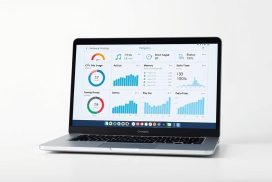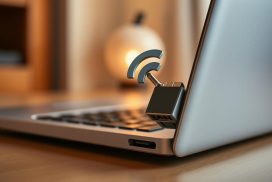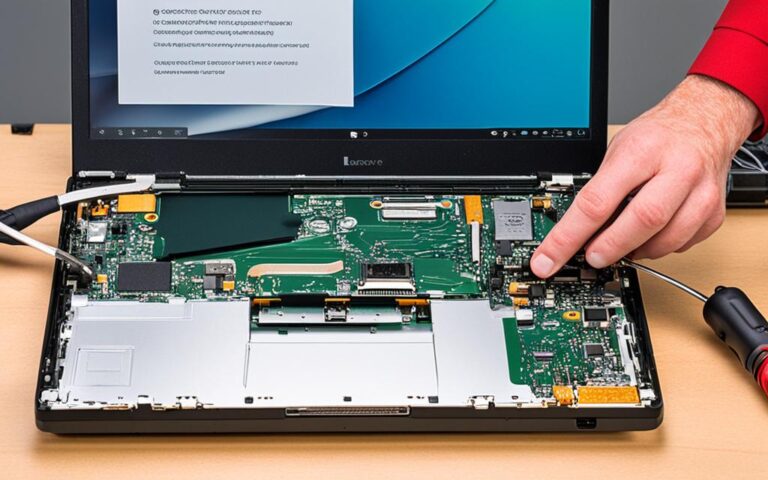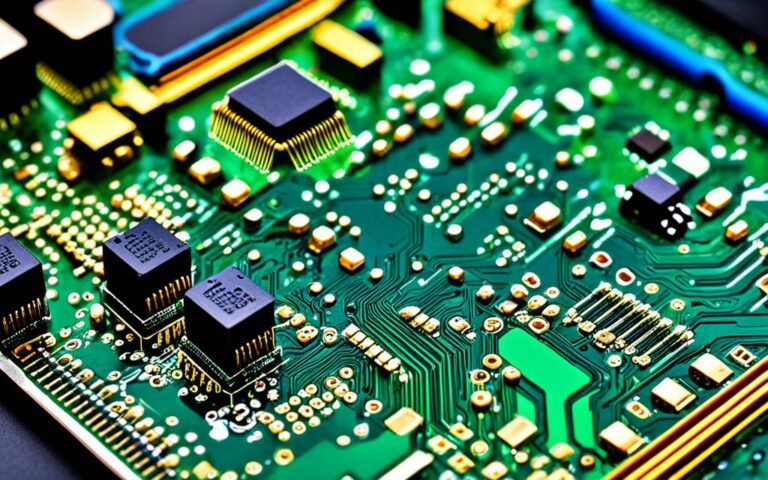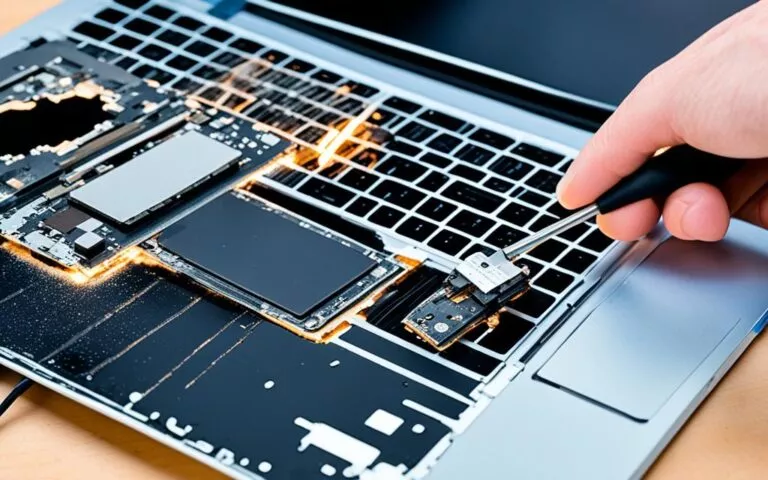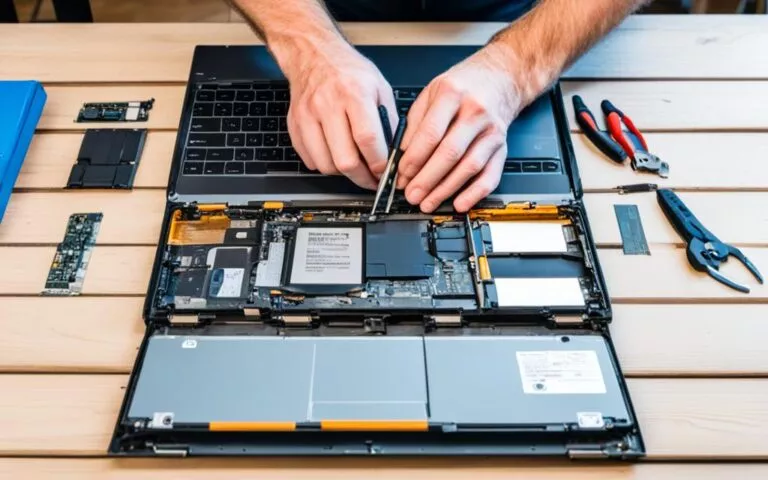Boost Your Laptop’s Performance: Top Fixes You Need to Know
Laptops are now a key part of our lives, with over 80% of people worldwide using them. Keeping them running well is vital for staying productive. About 50% of users face issues, mainly when they’re working on big tasks.
Slow performance can be due to not enough memory or disk space. To fix this, we need to find and solve these problems. Regular maintenance, like cleaning disks and restarting, can make a big difference.
Switching to a solid state drive can make tasks up to six times faster. Knowing how to keep your laptop fast can make your work easier. We’ll look at the best ways to improve your laptop’s speed, including software tweaks and storage upgrades.
Understanding Common Laptop Performance Issues
Laptop performance issues can really slow you down. Signs of poor performance include slow startup times, freezing, and crashes. These problems can come from many sources, like heavy programs, startup programs, and not enough storage.
Keeping your laptop in good shape can stop these problems. For example, restarting your laptop helps clear out temporary files. Also, turning off Power Saver mode and closing unused tabs can make a big difference. Managing startup programs, pausing OneDrive syncing, and updating your system can also boost performance.
Identifying Performance Bottlenecks
To find out what’s slowing your laptop, watch how it performs. Look for slow loading, crashes, and productivity impact. Fixing these issues can make your laptop run better and help you work faster.
Impact on Productivity
Slow laptops can really hurt your productivity. They make you waste time and effort. Knowing the signs of a slow laptop and fixing them can help you stay on track and focused on your work.
Essential System Diagnostics
Regular system diagnostics are key to keeping your laptop in top shape. They help spot problems early on. Running disk cleanups and checking for malware can boost your laptop’s speed and stop hardware troubles.
Diagnostic software is great for catching hardware errors and system events early. For instance, Windows Memory Diagnostic and macOS tools can spot issues before they get worse. Performance monitoring is also vital. It helps find overheating or performance issues, which might mean cooling system or hardware damage.
Some important tasks for your system diagnostics routine are:
- Running disk cleanups to free up space and improve performance
- Checking for malware to prevent security threats
- Monitoring system performance to identify any issues

Adding these tasks to your routine can stop performance problems and keep your laptop running well. Regular system diagnostics also cuts down the chance of hardware issues. These can pop up unexpectedly, even with regular care.
| Diagnostic Task | Frequency | Importance |
|---|---|---|
| Disk Cleanup | Weekly | High |
| Malware Scan | Daily | High |
| Performance Monitoring | Monthly | Moderate |
How to Fix Laptop Performance Through Software Optimisation
Improving laptop performance starts with software optimisation. This includes deleting temporary files, managing startup programs, and updating system drivers. These steps can make your laptop faster and more efficient.
Cleaning Temporary Files
Deleting temporary files regularly can help your laptop run better. It’s a good idea to do this at least twice a week. This keeps your laptop from slowing down due to these files.
Managing Startup Programs
It’s important to manage startup programs. Turning off programs you don’t need can make your laptop run smoother. This frees up resources and boosts performance.
Updating System Drivers
Keeping your system drivers up to date is key. Old drivers can cause problems and slow your laptop. Make sure to update them regularly.
By following these tips, you can make your laptop run better. Regular cleaning and maintenance help keep it in top shape. This way, your laptop will last longer and perform well.
| Software Optimisation Tips | Benefits |
|---|---|
| Delete temporary files | Free up disk space and improve laptop performance |
| Manage startup programs | Free up system resources and improve laptop performance |
| Update system drivers | Ensure hardware is functioning properly and improve laptop performance |
Memory Management Solutions
Keeping your laptop’s performance up is key. High memory use can slow it down, make apps slow, and stop file transfers. So, finding good ways to manage memory is vital.
RAM optimisation is a big part of this. Make sure your laptop has enough RAM for all you do. If you have 4 GB or less, adding more RAM can really help. Also, closing unused apps and stopping them from starting up can free up space and speed things up.
Techniques for Optimising Memory
- Regularly check for apps that use too much memory
- Defragmenting your hard drive saves memory and boosts speed
- Use a registry hack to clear page files at shutdown for better virtual memory use
Adjusting virtual memory is also important. It should be twice your physical memory to handle memory issues well. Using tools like EaseUS Partition Master can help manage your laptop’s memory and avoid slowdowns.
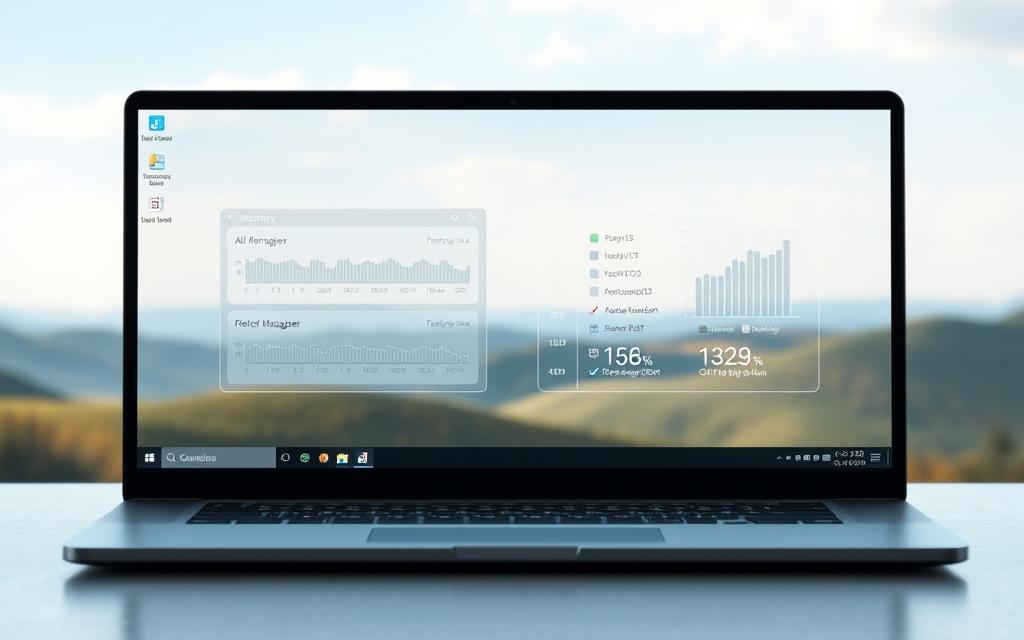
| Memory Usage | Solution |
|---|---|
| High Memory Usage (70-99%) | Upgrade RAM, close unnecessary programs, and disable them from startup |
| Low Memory Usage (less than 20%) | Monitor memory usage regularly and adjust virtual memory as needed |
Storage Solutions for Better Performance
Improving laptop performance starts with storage solutions. Upgrading laptop storage makes a big difference. It lets you access and process data faster. An external SSD is a great way to boost performance.
SSDs offer fast speeds, are durable, and have more storage. Switching to an SSD improves your laptop’s performance. It’s perfect for demanding tasks. Cloud storage is also good for storing big files and freeing up space.
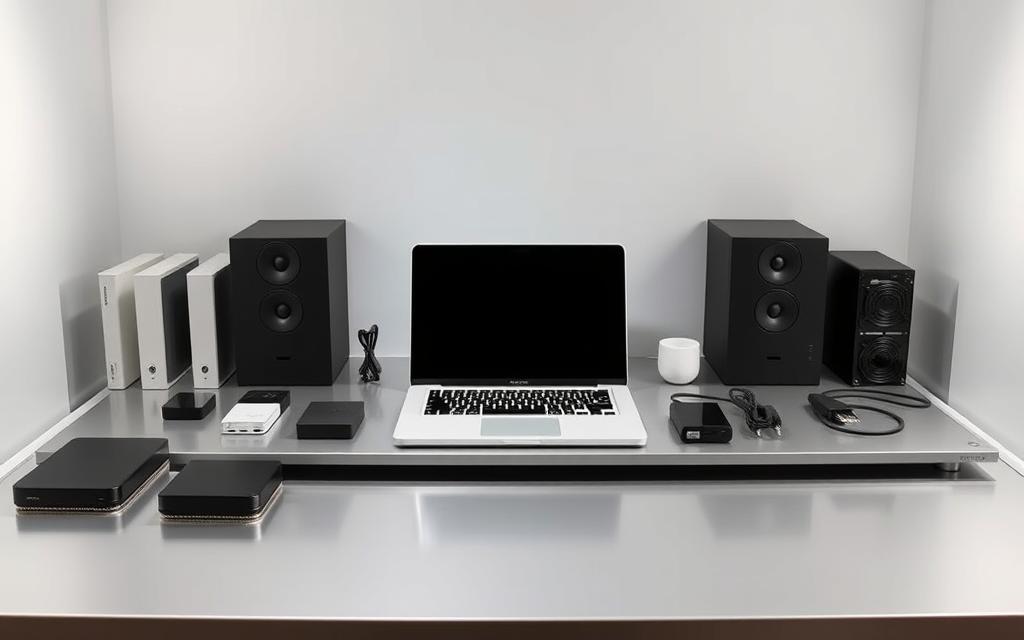
- Regularly clean up temporary files and empty the recycle bin to free up disk space
- Use disk defragmentation tools to improve data access speed
- Consider upgrading to a larger SSD or adding an external hard drive for extra storage
Using these storage solutions can greatly improve your laptop’s performance. Whether it’s an SSD, cloud storage, or optimizing space, the right choice makes a big difference. Your laptop will be more efficient and responsive.
| Storage Solution | Benefits |
|---|---|
| External SSD | Faster read and write speeds, improved durability |
| Cloud Storage | Increased storage capacity, convenient file access |
| Disk Defragmentation | Improved data access speed, enhanced performance |
Advanced System Tweaks
To boost your laptop’s performance, try advanced system tweaks. Power plan optimisation is a good start. It adjusts your laptop’s power settings for better performance and energy use. Switching to the High Performance plan can make your system more responsive and efficient.
Registry cleanup is also key. The registry is vital for Windows, and cleaning it can remove clutter. A tool like MiniTool System Booster makes this easy and safe.
System tweaks also mean tweaking system services and disabling unused features. For example, turning off search indexing can save resources. These tweaks can greatly enhance your laptop’s performance and your experience using it.
- Improved system performance and responsiveness
- Enhanced energy efficiency and battery life
- Increased disk space and reduced clutter
- Better overall user experience
| System Tweak | Benefits |
|---|---|
| Power Plan Optimisation | Improved system responsiveness and efficiency |
| Registry Cleanup | Removal of unnecessary registry entries and improved system performance |
| System Service Adjustments | Freeing up system resources and improving overall performance |
Hardware Upgrade Options
Upgrading your laptop’s hardware can make it run much better. Installing an SSD can speed up tasks by up to 600%. SSDs also use less battery power than old hard drives, which is great for laptops.
Adding more RAM helps your laptop handle many tasks at once. For a smooth experience, 8GB of RAM is good. But, 16GB is better for those who use many apps at once. Some laptops can even take up to 128GB of RAM.
Benefits of Upgrading to an SSD
- Improved everyday task speed by up to 600%
- Reduced battery power consumption by 30-50%
- Faster boot times, averaging between 10-13 seconds
Before you upgrade, check your laptop’s current hardware. Adding an SSD or more RAM can make your laptop much faster. It’s perfect for those who need a quicker laptop.
Considerations for a RAM Upgrade
Before you upgrade RAM, check your laptop’s specs. Some laptops can’t be upgraded because their memory is soldered. But, if yours can, more RAM will make your laptop 20-30% faster.
Maintaining Long-term Performance
To keep your laptop running well, follow some key maintenance tips. Restarting it often and cleaning dust can boost its speed. Also, disk cleanups help get rid of temporary files and free up space.
Here are some laptop care tips to keep your device in top shape:
- Limit startup programs to improve startup speed
- Regularly clean up unnecessary files and applications
- Update your operating system and software to ensure you have the latest security patches and features
By sticking to these maintenance tips, you can make your laptop last longer. Also, check your hard drive and consider adding more RAM if needed.
Looking after your laptop regularly can stop problems like overheating and battery wear. It also keeps software running smoothly. This way, your laptop stays reliable and efficient, giving you long-term performance.
| Maintenance Task | Frequency | Benefits |
|---|---|---|
| Restart laptop | Weekly | Improves performance, reduces memory usage |
| Clean up dust | Monthly | Prevents overheating, improves airflow |
| Run disk cleanup | Bi-weekly | Removes temporary files, optimizes storage |
Professional Tools and Software Recommendations
For the best laptop performance, using professional tools is key. These tools help with system monitoring, spotting and fixing performance issues. With performance optimisation software, laptops can work better. Expert reviews show that professional tools really make a difference.
Professional tools are great at system monitoring. They let users see how their laptop is doing in real-time. This helps find and fix problems. They also have features like disk cleanup and driver updates to boost performance.
Top professional tools include AVG TuneUp, Iolo System Mechanic, and Ashampoo WinOptimizer. They offer system monitoring, performance optimisation, and antivirus protection. Using these tools means your laptop will run smoothly, giving you a better experience.
Choosing the right professional tools is important. They can make your laptop faster, more efficient, and more productive. With the right tools, your laptop will perform at its best, giving you a great computing experience.
Conclusion: Keeping Your Laptop in Peak Condition
Maintaining your laptop’s performance and longevity is key. Regular laptop maintenance can extend its life by up to 50%. Neglecting care can lead to big drops in efficiency.
By following the tips in this article, your laptop will stay in peak condition. It will keep working well for you.
Software optimization, storage management, and hardware upgrades are vital. They keep your laptop running smoothly. Adding cleaning and power management tips will make your laptop last longer.
Getting help from experts for diagnostics and advanced services is also smart. They can help keep your laptop at its best.
A well-kept laptop works better and lasts longer. This saves you time, money, and the trouble of early replacement. Make maintenance a top priority to keep your laptop reliable and efficient.
FAQ
What are the common signs of poor laptop performance?
Signs of poor laptop performance include slow startup times and frequent freezing. Unexpected crashes can also happen. These issues can really slow you down and make daily tasks hard.
How can I identify performance bottlenecks on my laptop?
To find performance bottlenecks, start by checking for malware and running disk cleanups. Also, monitor your system’s performance. This will show you where the problems are.
What software optimisation techniques can I use to improve laptop performance?
To boost laptop performance, clean temporary files and manage startup programs. Update system drivers and run disk defragmentation. These steps can make a big difference.
How can memory management help boost laptop performance?
Good memory management is key. Optimize RAM, adjust virtual memory, and control background processes. Doing this can really speed up your laptop.
What storage solutions can I consider to enhance laptop performance?
Upgrading to an SSD or using external storage can improve performance. SSDs offer faster data access and better system responsiveness.
What advanced system tweaks can I perform to optimise laptop performance?
For better performance, try power plan optimisation, registry cleanup, and system service adjustments. These tweaks can make a big difference.
What hardware upgrades can I consider to boost laptop performance?
Upgrading to an SSD, adding more RAM, and improving cooling can enhance performance. These hardware changes can make your laptop run faster.
How can I maintain long-term laptop performance?
To keep your laptop running well, restart it regularly and clean out dust. Running disk cleanups is also important. Make a maintenance schedule and follow it.
What professional tools and software can I use to optimise laptop performance?
Use system monitoring apps, performance optimisation software, and antivirus solutions. These tools can help keep your laptop running smoothly.


